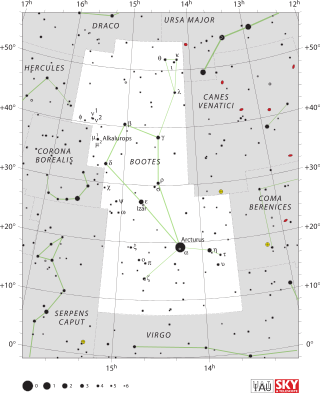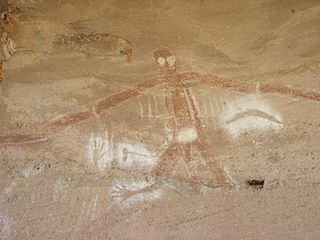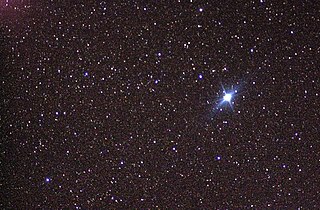
Arcturus is the brightest star in the northern constellation of Boötes. With an apparent visual magnitude of −0.05, it is the third-brightest of the individual stars in the night sky, and the brightest in the northern celestial hemisphere. The name Arcturus originated from ancient Greece; it was then cataloged as α Boötis by Johann Bayer in 1603, which is Latinized to Alpha Boötis. Arcturus forms one corner of the Spring Triangle asterism.

Corona Borealis is a small constellation in the Northern Celestial Hemisphere. It is one of the 48 constellations listed by the 2nd-century astronomer Ptolemy, and remains one of the 88 modern constellations. Its brightest stars form a semicircular arc. Its Latin name, inspired by its shape, means "northern crown". In classical mythology Corona Borealis generally represented the crown given by the god Dionysus to the Cretan princess Ariadne and set by her in the heavens. Other cultures likened the pattern to a circle of elders, an eagle's nest, a bear's den or a smokehole. Ptolemy also listed a southern counterpart, Corona Australis, with a similar pattern.

In Australian Aboriginal mythology, Baiame was the creator god and sky father in the Dreaming of several Aboriginal Australian peoples of south-eastern Australia, such as the Wonnarua, Kamilaroi, Guringay, Eora, Darkinjung, and Wiradjuri peoples.
In Australian Aboriginal mythology, Birrangulu or Birrahgnooloo is a fertility spirit who would send floods if properly asked. She is said to have had a long thin face.

Cassiopeia is a constellation in the northern sky named after the vain queen Cassiopeia, mother of Andromeda, in Greek mythology, who boasted about her unrivaled beauty. Cassiopeia was one of the 48 constellations listed by the 2nd-century Greek astronomer Ptolemy, and it remains one of the 88 modern constellations today. It is easily recognizable due to its distinctive 'W' shape, formed by five bright stars.
In Gamilaraay mythology, Bahloo is a male spirit representing the moon. The most known tale about him is a story about the origin of death.

36 Ophiuchi is a triple star system 19.5 light-years from Earth. It is in the constellation Ophiuchus.

Canopus is the brightest star in the southern constellation of Carina and the second-brightest star in the night sky. It is also designated α Carinae, which is Latinised to Alpha Carinae. With a visual apparent magnitude of −0.74, it is outshone only by Sirius.
The Gamilaraay, also known as Gomeroi, Kamilaroi, Kamillaroi and other variations, are an Aboriginal Australian people whose lands extend from New South Wales to southern Queensland. They form one of the four largest Indigenous nations in Australia.
The indigenous religion of the Pomo people, Native Americans from Northwestern California, centered on belief in the powerful entities of the 'Kunula', a Coyote, and 'Guksu', a spirit healer from the south.
Australian Aboriginal astronomy is a name given to Aboriginal Australian culture relating to astronomical subjects – such as the Sun and Moon, the stars, planets, and the Milky Way, and their motions on the sky.

Turtle Island is a name for Earth or North America, used by some Indigenous peoples, as well as by some Indigenous rights activists. The name is based on a creation story common to several Indigenous peoples of the Northeastern Woodlands of North America.

In cosmology, galaxy filaments are the largest known structures in the universe, consisting of walls of gravitationally bound galaxy superclusters. These massive, thread-like formations can reach 80 megaparsecs h−1 and form the boundaries between large voids.

Barnumbirr, also known as Banumbirr or Morning Star, is a creator-spirit in the Yolngu culture of Arnhem Land in the Northern Territory of Australia, who is identified as the planet Venus. In Yolngu Dreaming mythology, she is believed to have guided the first humans, the Djanggawul sisters, to Australia. After the Djanggawul sisters arrived safely near Yirrkala in North East Arnhem Land, Barnumbirr flew across the land from east to west, creating a songline which named and created the animals, plants, and geographical features.
The Yuwaalaraay, also spelt Euahlayi, Euayelai, Eualeyai, Ualarai, Yuwaaliyaay and Yuwallarai, are an Aboriginal Australian people of north-western New South Wales.

Kirsten Alexandra Banks is an Indigenous Australian astrophysicist and science communicator of the Wiradjuri people, known for her work in promoting mainstream and Aboriginal astronomy. She earned a Bachelor of Science in Physics from the University of New South Wales in 2018, and worked at the Sydney Observatory.
In Australian Aboriginal mythology, Ganhanbili or Kunnanbeili is one of the two wives of Bayaami, the other being Birrangulu.

Ghillar Michael Anderson, or Michael Ghillar Anderson, is a Euahlayi Elder and activist from Goodooga, New South Wales, in Australia.
Indigenous astronomy is the name given to the use and study of astronomical subjects and their movements by indigenous groups. This field encompasses culture, traditional knowledge, and astronomy. Astronomy has been practised by indigenous groups to create astronomical calendars which inform on weather, navigation, migration, agriculture, and ecology. Alongside calendric uses, constellations have names and stories that inform ceremony and social structures holding specific and deep cultural meanings for respective indigenous groups.











